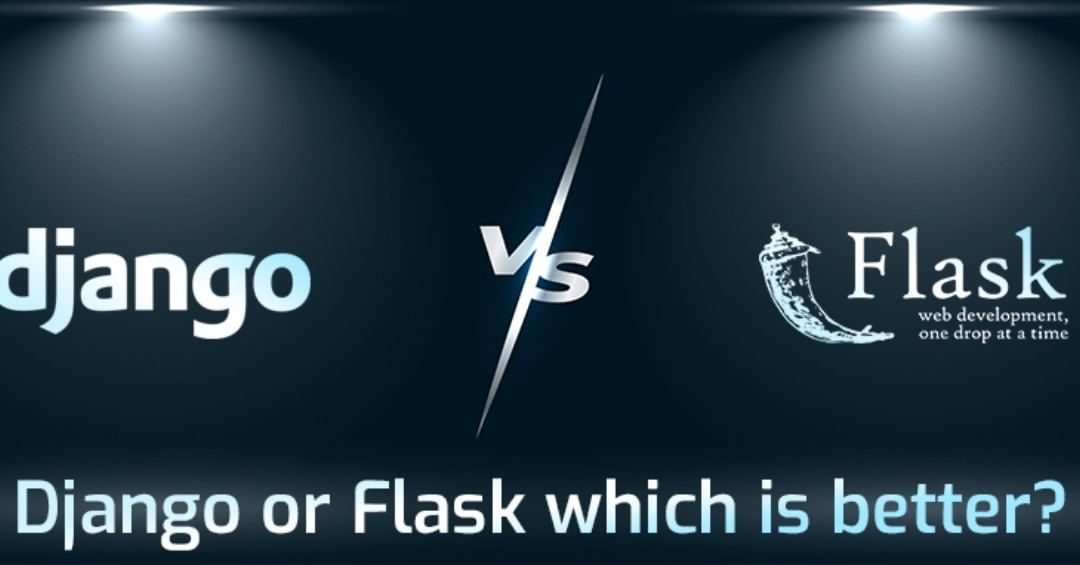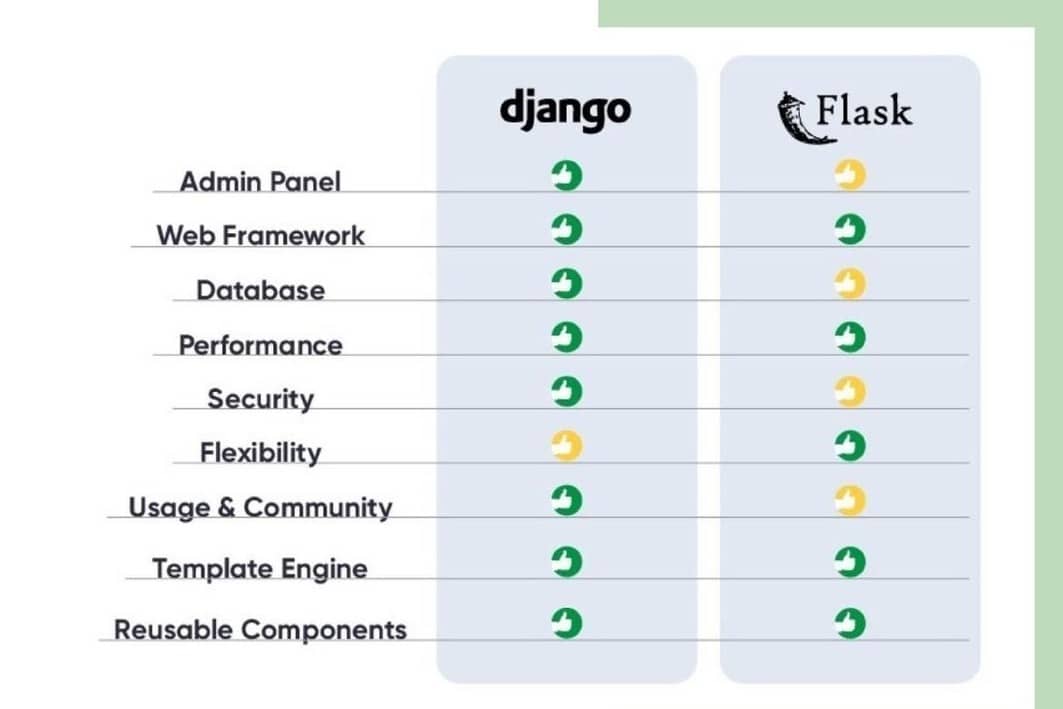Python web framework is a great tool for developing web applications. In this article we would compare 2 of the top python frameworks – Django vs Flask.
Django vs Flask – The table on basics
The aim of the project is to provide a faster, more concise way of creating web applications. It is also known as “the framework for perfectionists with deadlines”. Django uses the model view controller (MVC) pattern and is written in Python. Django has become one of the most used python web frameworks over time due to its versatility and large set of features.
Flask is a micro framework used for building web applications using Python. Compared to other web frameworks such as Django or Pyramid, it’s relatively minimal. Flask was created by Armin Ronacher, who describes it as “a lightweight WSGI micro framework for Python based on Wzeug, Jinja 2 and good intentions.
Flask is a micro framework used for building web applications using Python. Compared to other web frameworks such as Django or Pyramid, it’s relatively minimal. Flask was created by Armin Ronacher, who describes it as “a lightweight WSGI micro framework for Python based on Wzeug, Jinja 2 and good intentions.
Django is a powerful web framework written in Python built for rapid development. It has been adopted by many new developers due to its myriad of features, but at the same time it can be complex and hard to debug. Flask is a lightweight alternative with fewer functionalities, making it easier for testing and debugging. With less complicated structure, Flask also needs lesser time spent on maintenance.
Both Django and Flask have their own strong points that make them worthy choices as a web framework. Understanding which one suits your needs best will help you decide on trying out either Django or Flask first hand based on your requirements.
Django vs Flask – Applying a model view controller pattern
The Django framework is designed with the MVC pattern in mind. It consists of three components : models, views, and controllers.
Models exist to represent objects in your application. Django comes bundled with a database-abstraction layer that allows you to express SQL statements as Python code as well as an object relational mapper (ORM) allowing you to declare how each type of Python class maps into database table rows through declarative constructs known as models. The resulting API lets you interact with the database using natural Python syntax instead of having to write special queries or understand SQL syntax. Views handle any web requests and return responses according to what was requested by the client. Controllers handle external requests to the application, passing them off to views to generate appropriate responses. Controllers may also have additional responsibilities such as authentication or other security concerns.
Flask is a micro framework that does not include an MVC pattern out of the box. However it can be combined with other third party libraries that implement this pattern. Flask uses something called Blueprints, which are similar to Django’s App structure except they are used for adding functionalities on top of the core package rather than replacing it entirely.
Django vs Flask – Complexity & ease of debugging
Django is more complex compared to flask due to its large codebase and numerous modules making debugging difficult at times . It also has a steep learning curve and is characterized by its famous blog post “Four steps to Django nirvana” which acts as a tutorial for newcomers. As time progresses, more tutorials and guides become available on the internet that makes it easier to learn.
Flask has a smaller codebase compared to Django which makes every line of code easier to understand and debug . The Flask documentation is also very easy to follow which allows users with little Python experience to quickly adapt.
Django vs Flask – Learning Curve
Due to its large set of features and supported libraries, Django requires a larger learning curve than flask does . Since it supports different types of databases such as Oracle and MSSQL, beginners might find it difficult to maintain.
Flask is a relatively easier framework compared to Django. Flask has less code and does not use an MVC pattern which makes the learning process faster.
Django is a fantastically powerful web development framework, but it may be overkill for simple projects. If your requirements are basic, Flask might be more appropriate since it’s simpler to use and quicker to develop with. On the other hand if you need what Django offers then go for it! However, new developers should practice with Flask before moving on to Django in order to get comfortable with its structure and syntax.
Django vs Flask – Usage & community support
Django is a stable framework backed by a large community that provides constant updates and support for new Python versions . It has been adapted by many big organizations such as Instagram, Mozilla, Pinterest, The Washington Times and many more.
Flask is also backed by an active community that’s known to provide quick responses on issues through their google group or IRC channel . Flask also offers good documentation which makes it easier for developers to find solutions.
Django vs Flask – Reusable Components
Django has pre-built reusable components such as user authentication, registration, and password recovery. This feature makes development faster and easier. Django also provides a templating language that allows you to dynamically add blocks of code into existing templates in order to override template behavior.
Flask comes with support for URL routing which is used to map URLs to parts of your application . It also allows you to write custom Jinja2 templates which make it easy for developers to extend its functionality without modifying the original source. Since Flask is a micro framework , every component such as routing and template rendering must be supplemented by external libraries .
Django vs Flask – Scalability
There are various ways in which Django can scale depending on the nature of the project and the level of traffic.
Django is mainly used on high traffic websites such as Disqus, Pinterest and Instagram . Django scales well due to its modular structure that allows for better separation of concerns between various components such as models, views and templates. It also facilitates caching which improves performance by reducing server load.
Flask runs with Python’s inbuilt web server which makes it suitable for small projects with low traffic . Flask is a micro framework rather than a full stack framework like Django. Flask offers a pluggable system which makes it easier to add or replace parts in order to deal with specific issues or projects.
Django vs Flask – Performance & ease of deployment
Django uses the Werkzeug WSGI toolkit for its dispatch framework. It also uses cached template loaders in order to improve performance .
Flask has a microkernel architecture which only includes the components of Django that are essential to get it up and running . This makes Flask highly responsive, lightweight and easy to deploy. However, this approach might cause issues with large projects since Flask does not allow full customization.
Summary:
- – Django is powerful framework from python language which was used/adopted by many developers due to its features
- – Flask is lightweight framework built with python language which has lesser functionalities which makes it easier for debugging and testing
- – After understanding your requirements you can try either Django or flask based on the usage/need of your project.
Conclusion:
These are some of the things you need to consider when choosing between Django or Flask. Both frameworks have their own pros and cons but at the end of the day it all depends on your requirements, experience and personal preference. There is no right answer when it comes to frameworks! The most important thing is to pick the right tool for the job. Django and Flask are both great frameworks, but each has its own merits as well as disadvantages. Which one do you prefer?
Related post: Top 11 web development frameworks of 2022 – What You Need To Know


